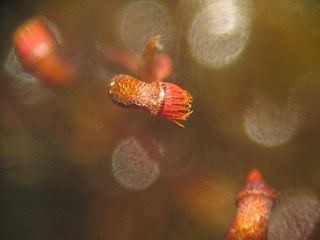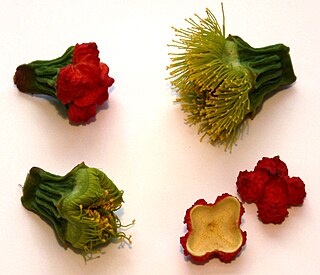
The cervix or cervix uteri is the lower part of the uterus (womb) in the human female reproductive system. The cervix is usually 2 to 3 cm long and roughly cylindrical in shape, which changes during pregnancy. The narrow, central cervical canal runs along its entire length, connecting the uterine cavity and the lumen of the vagina. The opening into the uterus is called the internal os, and the opening into the vagina is called the external os. The lower part of the cervix, known as the vaginal portion of the cervix, bulges into the top of the vagina. The cervix has been documented anatomically since at least the time of Hippocrates, over 2,000 years ago.

A gill is a respiratory organ that many aquatic organisms use to extract dissolved oxygen from water and to excrete carbon dioxide. The gills of some species, such as hermit crabs, have adapted to allow respiration on land provided they are kept moist. The microscopic structure of a gill presents a large surface area to the external environment. Branchia is the zoologists' name for gills.

In botany a capsule is a type of simple, dry, though rarely fleshy dehiscent fruit produced by many species of angiosperms.

Fish anatomy is the study of the form or morphology of fish. It can be contrasted with fish physiology, which is the study of how the component parts of fish function together in the living fish. In practice, fish anatomy and fish physiology complement each other, the former dealing with the structure of a fish, its organs or component parts and how they are put together, such as might be observed on the dissecting table or under the microscope, and the latter dealing with how those components function together in living fish.

Aquatic respiration is the process whereby an aquatic organism exchanges respiratory gases with water, obtaining oxygen from oxygen dissolved in water and excreting carbon dioxide and some other metabolic waste products into the water.

Mucus is a slippery aqueous secretion produced by, and covering, mucous membranes. It is typically produced from cells found in mucous glands, although it may also originate from mixed glands, which contain both serous and mucous cells. It is a viscous colloid containing inorganic salts, antimicrobial enzymes, immunoglobulins, and glycoproteins such as lactoferrin and mucins, which are produced by goblet cells in the mucous membranes and submucosal glands. Mucus serves to protect epithelial cells in the linings of the respiratory, digestive, and urogenital systems, and structures in the visual and auditory systems from pathogenic fungi, bacteria and viruses. Most of the mucus in the body is produced in the gastrointestinal tract.
Cervical dilation is the opening of the cervix, the entrance to the uterus, during childbirth, miscarriage, induced abortion, or gynecological surgery. Cervical dilation may occur naturally, or may be induced surgically or medically.

The Bryopsida constitute the largest class of mosses, containing 95% of all moss species. It consists of approximately 11,500 species, common throughout the whole world.

Pericoronitis is inflammation of the soft tissues surrounding the crown of a partially erupted tooth, including the gingiva (gums) and the dental follicle. The soft tissue covering a partially erupted tooth is known as an operculum, an area which can be difficult to access with normal oral hygiene methods. The hyponym operculitis technically refers to inflammation of the operculum alone.

The operculum is a series of bones found in bony fish and chimaeras that serves as a facial support structure and a protective covering for the gills; it is also used for respiration and feeding.

In botany, an operculum or calyptra is a cap-like structure in some flowering plants, mosses, and fungi. A calyptra is a covering, hood or lid, describing a feature in plant morphology.
This glossary of ichthyology is a list of definitions of terms and concepts used in ichthyology, the study of fishes.

An epiphragm is a temporary structure which can be created by many species of shelled, air-breathing land snails, terrestrial pulmonate gastropod mollusks. It can also be created by freshwater snails when temporary pools dry up.
This page provides a glossary of plant morphology. Botanists and other biologists who study plant morphology use a number of different terms to classify and identify plant organs and parts that can be observed using no more than a handheld magnifying lens. This page provides help in understanding the numerous other pages describing plants by their various taxa. The accompanying page—Plant morphology—provides an overview of the science of the external form of plants. There is also an alphabetical list: Glossary of botanical terms. In contrast, this page deals with botanical terms in a systematic manner, with some illustrations, and organized by plant anatomy and function in plant physiology.

A land snail is any of the numerous species of snail that live on land, as opposed to the sea snails and freshwater snails. Land snail is the common name for terrestrial gastropod mollusks that have shells. However, it is not always easy to say which species are terrestrial, because some are more or less amphibious between land and fresh water, and others are relatively amphibious between land and salt water.
A cervical mucus plug (operculum) is a plug that fills and seals the cervical canal during pregnancy. It is formed by a small amount of cervical mucus.

Wynnea americana, commonly known as moose antlers or rabbit ears, is a species of fungus in the family Sarcoscyphaceae. This uncommon inedible species is recognizable by its spoon-shaped or rabbit-ear shaped fruit bodies that may reach up to 13 cm (5.1 in) tall. It has dark brown and warty outer surfaces, while the fertile spore-bearing inner surface is orange to pinkish to reddish brown. The fruit bodies grow clustered together from large underground masses of compacted mycelia known as sclerotia. In eastern North America, where it is typically found growing in the soil underneath hardwood trees, it is found from New York to Michigan south to Mexico. The species has also been collected from Costa Rica, India, and Japan.

The skull roof, or the roofing bones of the skull, are a set of bones covering the brain, eyes and nostrils in bony fishes and all land-living vertebrates. The bones are derived from dermal bone and are part of the dermatocranium.

An operculum is an anatomical feature, a stiff structure resembling a lid or a small door that opens and closes, and thus controls contact between the outside world and an internal part of an animal. Examples include:

The Groasis Waterboxx is a device designed to help in growing trees in dry areas. It was invented and developed by Dutch former flower exporter Pieter Hoff, and won the Popular Science Green Tech Best of What’s New Innovation of the year award for 2010. The word "Groasis" is a neologism formed as a portmanteau of the words "grow" and "oasis".















